Table of Contents:
The age of Digital Transformation, the so-called Fourth Industrial Revolution, is demanding fundamental changes in how organizations operate and work. The increased integration of digital technology into all areas and workflows of organizations drives an immediate need for rapid employee skills development.
According to the 2019 LinkedIn Workplace Report, the number one focus of talent developers and Learning and Development (L&D) professionals is to identify, assess, and close the skills gap needed to augment their organizations’ ability to evolve and stay relevant.
Coming in at number two, but still remaining critical and an ongoing challenge, is increasing learner engagement. Now more than ever, the need to revisit how we apply adult learning theories in the context of corporate learning and development settings.
Understanding how adults learn can help L&D teams plan training interventions during conception, development, and delivery, that will facilitate the learning process and:
- Map courses based on relevance with perceived learner needs,
- Use appropriate instructional strategies in alignment with real learning contexts,
- Choose the approach that best supports the instructional strategy, and
- Plan instructional strategies to keep pace with the digital transformation of the company and time-constrained learners.
As we draw insight into how adults learn and understand the principles of adult learning, we can effectively apply them and address the challenges of engaging our learners.
Engaged Learning is Essential in Digital Transformation
Digital transformation demands organizations to create new or modify existing organizational processes, infrastructures, culture, and how it engages with its customers to meet business and market requirements.
As important to all the elements involved in the metamorphosis of the company is the ‘people’ part of digital transformation. And alongside this is the need for new training and development initiatives that enable employees to evolve their skills with the ever-changing landscape around them.
Pressure intensifies as L&D professionals are tasked to find better ways to engage employees, and continuously motivate them to develop their skills, and growth opportunities within the organization.
Engaging learners is a critical component of a sound learning strategy and can drive game-changing results of an organization. While this sounds simple, this has been an ongoing challenge for educators and L&D professionals.
Providing learning experiences and strategies that engage hearts and minds that transform the learner is the ultimate goal of all L&D practitioners. But as corporate training evolves into a variety of blended learning modes, and is complicated by innovations in technology, a mobile workforce, and a myriad of social networking tools, engaging learners is a worthwhile challenge that can be overcome.
The key to managing and integrating all the factors that influence corporate training initiatives requires understanding and careful planning.
Let’s begin with understanding what learning engagement means.
There is considerable variation in how “learner engagement” is defined. However, in general, the term is used to describe the willing and meaningful participation of an individual throughout the learning process that directly contributes to achieving the desired outcomes.
Learner engagement is influenced by three factors. All three types must be addressed to ensure effective performance and knowledge retention.
Is your evaluation program hurting the talent? Here is an interesting read to fix the problem. Download now!
Factors and Indicators of Learner Engagement (Figure 1)
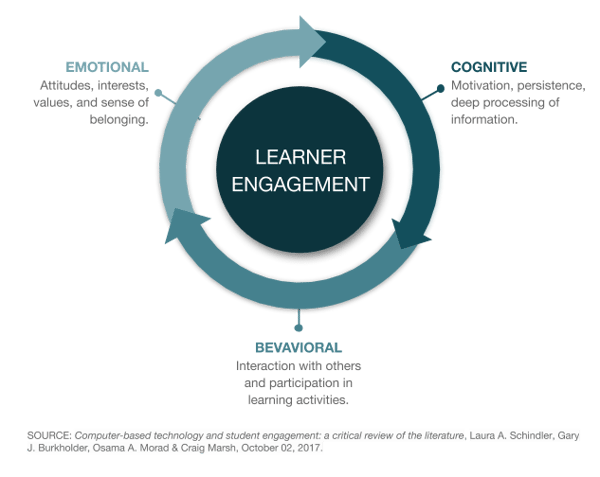
 |
EmotionalIs the learner’s emotional reaction to or “connectedness” with the training, its context, and its content. Indicators of emotional engagement include attitudes, interests, and values towards learning, and a perceived sense of belonging within a learning community. Emotional engagement is often assessed using self-report measures (Kirkpatrick Model Level 1, reaction, training evaluation model) and provides insight into how students feel about a particular topic, delivery method, or instructor.
|
|
|
CognitiveThe learner’s cognitive involvement and investment in their learning. This means active participation in the learning process through the sustained intellectual effort to comprehend and master content. When a learner is cognitively engaged, they take the initiative to represent what they learn in their own context and utilize learning strategies that work for them to absorb and retain information effectively. Discover how to foster a love of learning with your training programs and courses with a complimentary eBook on Getting Engaged: How To Make Your Learners Fall in Love with Learning. |
|
|
BehavioralThe learner’s interaction and level of participation in the learning process. Indicators of behavioral engagement reflect observable actions which include time and effort spent participating in learning activities and interaction with peers and others related to the learning experience. Adult learners are more engaged on an emotional and intellectual level when their own work and life experiences are brought into their learning. And as they share those experiences with others, their engagement grows even stronger. Enabling learners to socialize with other learners and mutually learn from each other’s experiences, is a critical aspect of behavioral engagement as it serves as an anchor that keeps drawing adult learners in, keeps them motivated, and even inspired. A key factor that is often overlooked in the development and implementation of training interventions is the environmental factor of learner engagement. This is a significant factor that influences behavioral engagement. Training and the process of learning do not end when the training event itself is over. For knowledge to manifest itself in the workplace, it requires reinforcement and application, and practice in the context of the employee’s functional routine. To address the need for behavioral engagement, we need to re-examine our organizational culture to ensure that they support and cultivate a suitable learning environment. Some questions to be asked are:
For more in-depth insights into training evaluations and learner engagement, grab your free copy of The Practical Guide to Evaluating Your Workplace Learning Effectiveness. |
The emotional and intellectual response engagement factors of the learner to training (content, treatment, relevance to the learner, etc.) are directly influenced by thoughtful course design, development and implementation which are comprehensively anchored in Adult Learning Theory and Principles.
Let's put eLearning in action! Check out the infographic below for some of the eLearning tactics and tools to increase employee and learner engagement with results to increased productivity, better learning retention, and more!
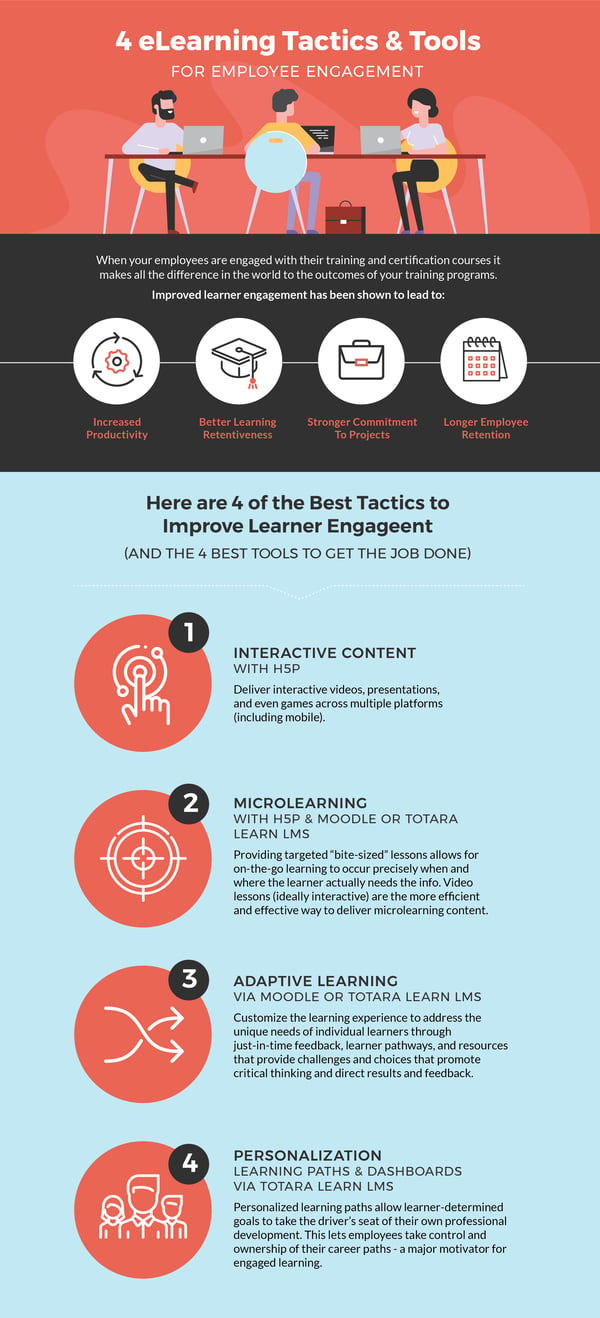
What is Adult Learning Theory?
Adults are complex individuals, so there is no one-size-fits-all learning theory that can be applied to them.
 Many models, assumptions, principles and theories were put forth in the last century that make up the adult learning knowledge base, but they all agree on the premise that adults learn differently than children. And, one thing that all adult learning theories have in common is the goal of creating effective learning experiences for the adult corporate learner.
Many models, assumptions, principles and theories were put forth in the last century that make up the adult learning knowledge base, but they all agree on the premise that adults learn differently than children. And, one thing that all adult learning theories have in common is the goal of creating effective learning experiences for the adult corporate learner.
In the field of adult learning theory, one theorist stands out for a number of important ‘firsts’.
Malcolm S. Knowles, an American educator, was the “first to chart the rise of the adult education movement in the United States; the first to develop a statement of informal adult education practice; and the first to attempt a comprehensive theory of adult education (via the notion of andragogy)”.
In his attempt to document the difference between the ways adults and children learn, he popularized the concept of andragogy. This term was originally coined by German educator, Alexander Kapp in 1833. It was later developed into a theory of adult education by Eugen Rosenstock-Huessy. However, Knowles popularized its usage for English language readers.

Malcolm Knowles defined andragogy as the “art and science of helping adults learn”. His work has provided the fundamental framework for adult learning and education. In fact, his five assumptions that characterize adult learners correspond directly to the Adult Learning Principles we refer to today.
Knowles identified factors upon which adults and children can be contrasted: self-concept, experience, readiness, orientation, and motive.
He then premised a set of assumptions that distinguish the characteristic between the two.
The table below compares the differences between andragogy vs. pedagogy in the context of Knowles’ five assumptions of adult learners.
Andragogy vs. Pedagogy: Knowles’ Assumptions Characterizing Adult Learners (Figure 2)
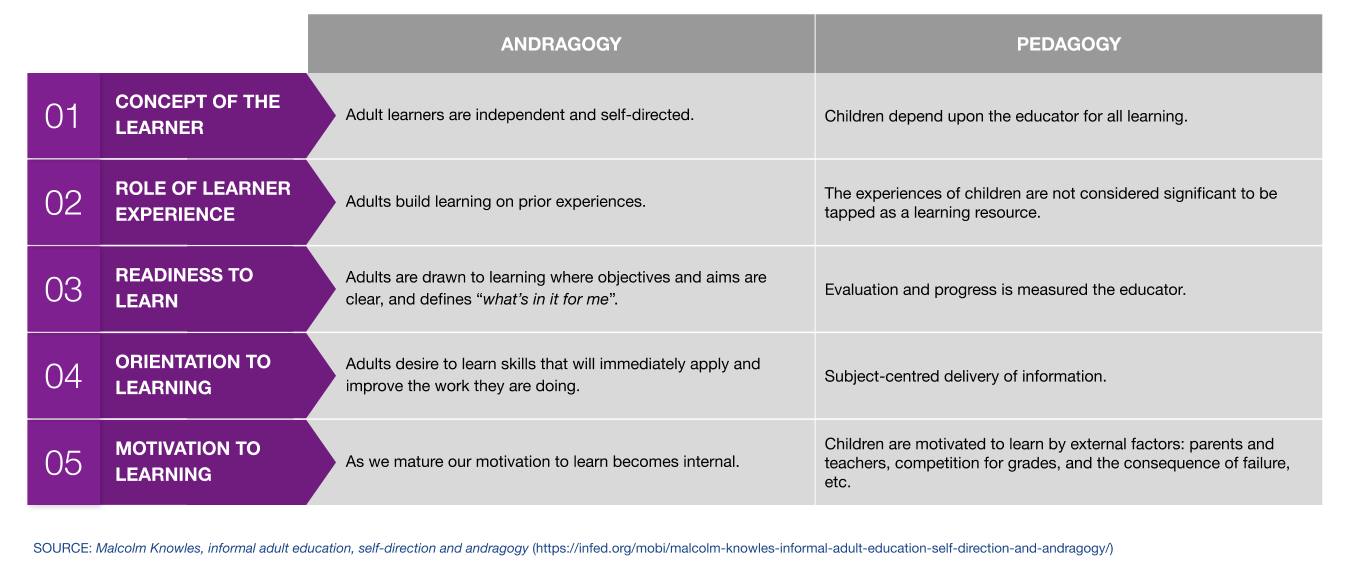
The fact is, adults have more complex drivers to learn. Adults recognize what has worked for them in the past or have behaviors that affect the way they learn and receive new information.
Moreover, adult learning drivers are intrinsically motivated, and so continued use of traditional pedagogical modes of instruction are less effective and engaging. Knowles’ 5 assumptions that characterize adult learners have inherent implications that impact how we approach instructional design for adults, and correspond directly to the Adult Learning Principles we refer to today.
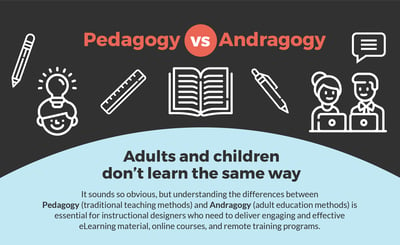 |
| Click the above image to open up an infographic to summarize the difference between pedagogy and andragogy! |
Based on the five assumptions of andragogy that characterize adult learners, Malcolm Knowles postulated four principles that are applied to adult learning.
Four Principles of Andragogy (Figure 3)
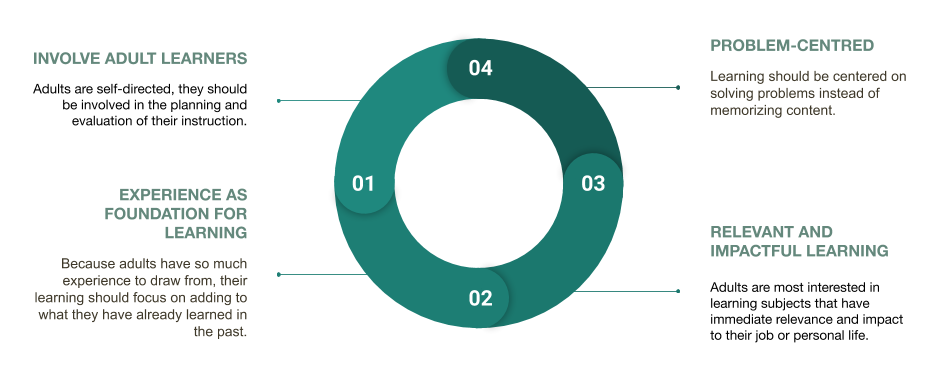
Putting It All Together: Applying Andragogy To Corporate Learning
Andragogy applies to any form of adult learning. It guides L&D professionals on how to connect learning experiences to what adult learners already know. It has been used extensively in the design and development of organizational training programs. By incorporating personal context, knowledge checks and re-checks, andragogy enables adults to leverage what they already know against the new topics they are presented with.
Now let us look at how Malcolm Knowles’ Adult Learning Theory and Principles can be applied in your corporate learning strategy and increase the engagement of your learners.
Implementing Knowles’ 5 Assumptions
Andragogy recommends L&D professionals to take the learner's experiences and interests into consideration when creating corporate learning training interventions.
Personalities, differing past experiences, current orientations, levels of readiness for learning, and individual learning styles are variables that training practitioners should be cognizant of before prescribing any standardized approach to facilitating learning (Brookfield, 1986).
Understanding the assumptions that characterize adult learners prepares L&D professionals in creating engaging corporate training experiences.
1. Concept of the Learner
Adult learners are independent and self-directed.
 As we become adults, our mode of learning shifts from a dependent relationship between learner and educator into independent self-directed pursuit.
As we become adults, our mode of learning shifts from a dependent relationship between learner and educator into independent self-directed pursuit.
Moreover, when we are encouraged to explore topics on our own and work autonomously, we acquire new information and build upon existing knowledge much more effectively.
However, Knowles points out that while adults have this self-concept of being responsible for their own decisions, they resist situations where they feel others are challenging their independence.
There is a persistent problem in adult education where adults learners put on what Knowles refers to as “dunce hats of dependency.” This attitude in many adult learners expecting to be treated as dependents, is a residual tendency formed on earlier K12 experiences and conditioning.
As a consequence of not being full participants in their own learning experiences, adult learners revert back to expecting to be spoon-fed information. Although Knowles first viewed andragogy as being separate from pedagogy, he later revised his views and stated that both coexist on a continuum.
This has implications on corporate learning and L&D professionals:
- Adult learners may not know how to be active, self-directed learners.
- Challenge in transforming and engaging adult learners as they transition from passive to active learning.
In order to address these two points, the choice is the key component to engaging your adult audience. In all aspects of your corporate learning culture, environment, and learning experiences, actively think about what options you can offer to enable and empower your learners with being responsible for their learning.
This assumption is a key pillar to achieving learner engagement on multiple levels as it influences a learner’s attitudes, sense of self as an individual and as a member of a learning community that is supportive.
Create an environment to develop self-directed learning skills
To begin with, it is important for organizations to create environments where adults are able to develop their latent self-directed learning skills.
Self-directed learning is a method of:
- Organizing training and learning so that they are within the learners' control, and
- Setting a goal towards which learners accept personal responsibility for their own learning, achieve learning independence, and exercise personal choice.
Success in the first view would lead to attaining the second. So the key to achieving this is to have a support system in place to serve as a framework, guide and reference. This “scaffolding” will help employees who are not yet independent learners fill their knowledge gap while developing self-directed learning skills. Contextual Help tips, a “Before you Begin” module or a User Guide, or a support Contact, etc. are useful non-intrusive assistive strategies, while still giving learners all the resources they need to learn on their own terms.
Other strategies to use to develop self-directed learning skills, learning activities such as simulations, scenarios, or games may also be offered with little to no additional information. As adult learners explore the activity on their own, they learn and decide which benefits and information they can take away from the learning experience.
Foster a sense of responsibility through choice of engagement
Once the support systems are in place, and your learners are taking responsibility for their own learning, extend the practice of independence and choice by offering options in how learners can engage with your training assets, resources, and activities. For example, training might come in the form of self-study or group collaboration projects that involve minimal instructor intervention. Additionally, the training content can be offered in multiple formats: having audio, video, and text options for each major point in a learning experience. Giving choice to learners can also mean offering different ways of interacting with the content (e.g., offering a self-paced course and a synchronous course). It may mean providing additional resources and readings or external options so the learners can decide the depth into which to go on a topic.
Everything you need to know to get the best results from your courses and training programs can be found in this guide on The All-Important E’s of eLearning: Engagement & Effectiveness
Encourage how learners apply their new knowledge on-the-job
The role of the learner’s manager or supervisor in successful training transfer cannot be underestimated.
Knowledge retention, skills development and practice, and finally behavioral change are effected as the manager and learner determine what the practical application of what has been learned looks like.
Once training has been completed by the learner, it is important for the manager and learner to have a post-training briefing to discuss the monitoring, application and evaluation of what has been learned.
This is a very critical stage as the learner and the manager collaborate on how the subsequent assumptions of experience, readiness, orientation and motivation will drive the learning success.
2. Role of Learner Experiences
Adults build learning on prior experiences.
Adults retain experiences and reference them for learning purposes. We become more intuitive with age and experience as we learn from mistakes.

When designing and developing your courses and learning activities, make sure you take the diversity of your learning audience into account, especially in terms of backgrounds, experience levels, and skill sets.
To accommodate the differing needs of adult learners, consider using a variety of different instructional design models and theories into your course or module.
Taking the time to conduct a preliminary survey of your audience to assess the technical gaps and the skill levels they may have, will make the difference between an informative and engaging learning experience, or one that is challenging, frustrating, and tedious.
Knowles valued the experience learners brought to the learning environment and recognized that drawing on learners’ experiences represents a great opportunity. He noted that in many instances adults were the best resources for one another.
Peer learning offers the potential for one learner’s experience to directly help another learner. As such, he encouraged and emphasized group discussions and collaborative work that would rely on the expertise within groups.
To incorporate this assumption into your corporate training initiatives, utilize social media and online collaboration tools to tie learning to social development. Moreover, this greatly contributes to increasing the behavioral engagement of your learners.
Knowles also offered a list of other strategies to elicit the experience and prior knowledge adult learners bring. Make use of approaches that encourage learners to take time to reflect, discuss questions, work on case- and problem-based activities, simulations, and hands-on practice.
3. Readiness to Learn
Adults are drawn to learning where objectives and aims are clear, and defines “what’s in it for me”.
Having an incentive is a driver that inclines us to learn, e.g., growth or development of a skill, or a facet of our professional/personal life. As such, we are more ready to learn when it is immediately relevant and useful.

In your training programs provide exercises and activities that prompt learners to tie what they’re learning back to their own lives and work. And, where possible, we should provide bridges that encourage that tie-back and application: checklists, worksheets, and other tools learners can use in the context of their lives and work.
Moreover, to engage learners on an emotional, cognitive and behavioral level, make sure that you always provide context.
Connecting your training interventions and learning assets to organizational, departmental, team and individual goals deepens the learners sense of purpose and overall sense of belonging.
4. Orientation to Learning
Adults desire to learn skills that will immediately apply and improve the work they are doing.
As we get older, our responsibilities and priorities as adults change, according to our state in life, e.g., job, family, etc. Consequently, our perspective of time shifts as a result of limitations on our time to learn things just for the sake of knowing.
This results in a shift in our approach and motive to learning.
Adult learners tend to be life-centered (or task-oriented, or problem-based and solution-oriented) as opposed to subject- or content-centered.
Orientation to learning is very similar to the previous one, readiness to learn. However, the key difference between the two is that “readiness to learn” focuses on engaging the adult learner to learn, while “orientation to learning” focuses on engaging the adult learner as they learn; in other words, knowledge-related goals are considered less effective in the process of learning as well as the inspiration for learning.
Orientation to learning dovetails with the readiness to learn as a means of being able to immediately apply what has just been learned or discovered.
Before actively engaging in a learning process, adults essentially examine the purpose and timeliness of something. Not only do we want to know why we need to acquire specific information, but whether or not it can be readily applied.
In our training solution, we should emphasize how the topic is going to remedy problems that learners regularly encounter and offer real-world examples and scenarios.
Recognizing that time is a factor for adult learners, another strategy to employ is microlearning.
Microlearning is a type of training delivered in small units that can be consumed in 5 to 10 minutes. They’re designed to help learners tackle a large volume of learning content by taking small but meaningful chunks.
Microlearning courses target one certain learning objective at a time: one lesson = one skill that focuses on results here and now.
This approach to course design offers learners learning solutions that are “just in time”, readily accessible and consumable as well as support the option to learn while on the go – commuting to work or even when standing in a traffic jam.
Discover the best ways to bring microlearning to your organization with this free on-demand webinar: Microlearning - Why You Should Order the Nuggets!
5. Learner Motivation
As we mature our motivation to learn becomes internal. We want to learn for our own reasons: to boost self-esteem, get a raise, develop new skills, etc.
 While adult learners respond to both external and internal motivations, internal pressures prove to be the most compelling. As such, there is a need to explain why a particular learning activity, assessment, or module is being taught and why participation is necessary. Doing this will make the overall learning experience meaningful and engaging.
While adult learners respond to both external and internal motivations, internal pressures prove to be the most compelling. As such, there is a need to explain why a particular learning activity, assessment, or module is being taught and why participation is necessary. Doing this will make the overall learning experience meaningful and engaging.
As part of the employee development strategy, goal setting and making use of learning plans are powerful tools in motivating learners.
This approach gives us the opportunity to leverage motivation at three key points:
- When a decision is made to engage in a learning experience, e.g., purchasing a course, participating in a conference, or devoting time for self-study. The individual employee is motivated as they exercise their independence to choose to learn, decide what to learn, and how to learn.
- During the learning experience itself. Enabling learners to socialize their learning experience with others during the process creates an internal motive that can deepen their level of emotional, cognitive, and behavioral engagement.
- Application of learning on the job. When a learner collaborates with their manager or supervisor on how, when and how well what has been learned is applied on the job, creates an internal motive to succeed.
Learn exactly how you utilize learner motivation to Attract Star Talent (And Keep Them!): Learning Paths for Employee Retention in this how-to guide
Implementing Knowles’ 4 Principles of Adult Learning
1. Involve Adult Learners
Adults need to be involved in the planning and evaluation of their instruction.
Adult learners also need to feel as though they are more involved in the process of learning and have some control over it.
By empowering employees in the decision-making process of their learning journey, they recognize the validity of the course and appreciate the need for acquiring new knowledge or skills.

In order for your training and coursework to be effective, it must not only acknowledge differences in learner experiences, but also offer learning paths that appreciate this experience and are tailored accordingly.
Malcolm Knowles proposed an 8 step Learning Process Design Elements for adult learners in order to implement and capitalize upon the assumptions of andragogy that encompasses a wide range of activities which occur before, during, and after the learning experience, including:
- Preparing the learners
- Climate setting
- Mutual planning
- Diagnosis of learning needs
- Formulation of learning objectives
- Learning plan design
- Learning plan execution
- and evaluation
See Figure 4 (Learning Process Design Elements for Adult Learners), below for additional details.
2. Experience as a Foundation for Learning
Experience (including mistakes) provides the basis for the learning activities.
Adult learners have very diverse backgrounds and varying experiences. Utilize exercises, activities and group-based discussions that allow participants and share their personal experiences helping others learn.
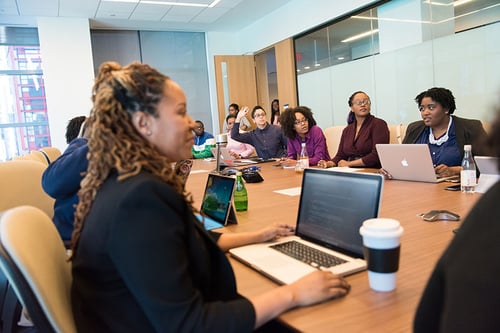
Rather than offering memorization tasks, create projects and exercises that encourage adult learners to go out and explore the subject matter, thereby gaining experience. By doing this, adult learners can learn from their errors and master their skills sets through first-hand experience. In line with Knowles’ theory of andragogy, L&D professionals need to recognize that adult learners have within them a wealth of knowledge and experience. Therefore, for greater impact, the use of experiential techniques that tap into the experience of learners should be used, such as:
- group discussion,
- problem-solving activities,
- case studies,
- scenario-based,
- simulation exercises,
- storytelling,
- games, gamification,
- badges and certification,
- role-play.
3. Relevant And Impactful Learning
Adults are most interested in learning subjects that have immediate relevance and impact on their job or personal life.

In addition to considering users’ experiences and pre-existing knowledge levels, it’s also important that the content you create is directly applicable to their current needs. In his research, Malcolm Knowles found that adults learn best when:
- They understand why something is important to know or do;
- They have the freedom to learn in their own way or preferred method;
- Learning is experiential and is directly applicable to their needs;
- The time is right for them to learn (on-the-job as they encounter it); and
- The process of learning is positive and encouraging.
According to a recent study, adult learners have a preference for online, self-paced training. By offering coursework that can be completed independently and on-demand, the pressure on learners to “squeeze in” training is reduced. This approach is optimal as learners complete courses when they are in the best frame of mind to learn.
4. Problem-Centered
Adult learning is problem-centered rather than content-oriented.
As adults, we need to be able to relate what we are learning to real-world benefits and applications. To increase learner engagement, the learning experience should achieve one (or more) of the following goals:
- Make the learner more efficient and make their job easier;
- Help learners develop new skills and move towards job advancement;
- Assist in the completion of a critical task.
By integrating activities such as problem-based scenarios and case studies into adult eLearning courses, adult learners have the opportunity to directly see how what they are learning can be used in the real world. Adult learners can take on their own approach when solving problems, which will give them the chance to use their knowledge in a practical way.
Learning Process Design Elements for Adult Learners (Figure 4)
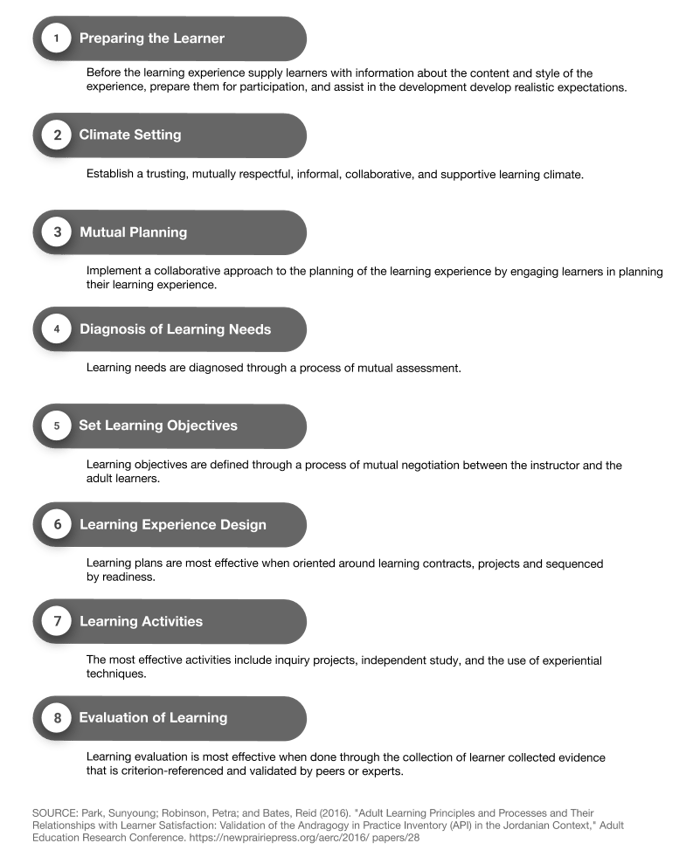 Learner engagement in the workplace continues to be a challenge in many organizations. And with external pressures from market demands forcing organizations to keep up with the digital transformation, companies are equally facing internal challenges addressing the resulting skills gap in their workforce, and providing much needed effective training opportunities, as a means to develop, maintain and even attract new talent.
Learner engagement in the workplace continues to be a challenge in many organizations. And with external pressures from market demands forcing organizations to keep up with the digital transformation, companies are equally facing internal challenges addressing the resulting skills gap in their workforce, and providing much needed effective training opportunities, as a means to develop, maintain and even attract new talent.
Corporate learning, therefore, plays a greater role in organizational strategy where L&D professionals are held responsible for being able to demonstrate the impact of their initiatives.
Training and development need to evaluate their programs to make sure their learners are engaged, empowered, and responsible for their self-development.
Going back to Malcolm Knowles’ adult learning theory you can create training experiences that will enhance the learning of participants. When adults participate in a positive learning experience that follows the assumptions and principles of andragogy, they are more likely to be more engaged, retain what they have learned, and apply it in the workplace.
If you’re looking for more expert advice and how-to content on adult education, andragogy, and fostering employee engagement with your courses and training programs, here’s what our eLearning experts have put together for you:
- eBook: Attract Star Talent (And Keep Them!): Learning Paths for Employee Retention
- eBook: The All-Important E’s of eLearning: Engagement & Effectiveness
- eBook: Getting Engaged: How To Make Your Learners Fall in Love with Learning
- eBook: Using Analytics to Deliver Engaging Courses
- Webinar: How to Create Engaging and Effective eLearning
- Webinar: How To Use Interaction To Drive Engagement And Learning Outcomes
- Webinar: How to Reduce Disengagement with Gamification
- Webinar: Top 5 Practical Applications for Building Engaging Learning
References:
- Smith, M. K. (2002) ‘Malcolm Knowles, informal adult education, self-direction and andragogy’, The encyclopedia of pedagogy and informal education, www.infed.org/thinkers/et-knowl.htm.
- An Essential Guide to Andragogy for Learning Businesses, Celisa Steele, https://www.leadinglearning.com/guide-to-andragogy/
- Knowles, M. S. (1980). The modern practice of adult education: From pedagogy to andragogy. Chicago: Follett.
- Brookfield, S. D. (1986). Understanding and facilitating adult learning: A comprehensive analysis of principles and effective practices. California: Jossey-Bass, Inc.
- https://itcdland.csumb.edu/~salkadhi/evidence/Alkadhi_Final_Paper.pdf
- https://www.learning-theories.com/andragogy-adult-learning-theory-knowles.html#_edn2
- https://www.ncbi.nlm.nih.gov/pmc/articles/PMC1125068/
- https://icu.repo.nii.ac.jp/?action=repository_action_common_download&item_id=4453&item_no=1&attribute_id=22&file_no=1
- https://elearningindustry.com/9-tips-apply-adult-learning-theory-to-elearning
- https://www.joe.org/joe/2006december/tt5.php









